(Site of) West Façade of Pan-Pacific Auditorium
1935 – Plummer, Wurdeman & Becket
7600 Beverly Boulevard – map
Declared: 3/1/78
The architectural firm of Plummer, Wurdeman & Becket created the Pan-Pacific Auditorium as a temporary structure, initially serving the National Housing Exposition’s run for a few weeks during the summer of 1935. The big barn, however, went on to host all sorts of tradeshows, concerts, sporting events, circuses, horse shows, roller derbies, and political rallies, before being shuttered in 1972.
A massive (400' x 250' with eighteen 130-foot arch-rib trusses and 110,000 feet of floor space) wood-frame, stucco-covered building, the auditorium was the centerpiece of the twelve-and-a-half-acre exposition grounds off Beverly and Fairfax, just east of Gilmore Stadium. The outstanding feature of the Pan, of course, was the Streamline Moderne façade, with its four green and white pylons and soaring flagpoles. With Wurdeman in charge, the architects created one of Los Angeles’s most iconic landmarks in the Depression years. (Charles F. Plummer would die four years later. Walter C. Wurdeman and Welton D. Becket then teamed up to design buildings all over the southland. After Wurdeman's death, Becket worked on the Capitol Records Building and the Music Center downtown.)
Built in just fifty-six days, the Pan-Pacific Auditorium opened May 18, 1935, as “the largest of its sort in the West and one of the three largest in the nation.” The 500-member Tenth Olympiad Chorus sang at the dedication ceremonies that Saturday night.
In the 1940s, the Pan-Pacific became a permanent full-service auditorium. The concrete slab floor was claimed to be the “world's largest indoor ice rink.”
If you were a kid in Los Angeles in the 1960s, there’s a good chance you saw the Harlem Globetrotters, the Ice Capades, or a circus or two here. The Pan was also the site of Elvis Presley’s first west-coast concert. Q: How awesome would it have been to see Elvis with Scotty Moore, Bill Black, and D.J. Fontana and the Jordanaires perform here? A: Very awesome, indeed. And for $3.75 (cheap!), too. Click here for thorough coverage of his October 1957 visit.
A cafe in the auditorium.
Along with the Grand Olympic and Shrine auditoriums, the Pan-Pacific became one of Southern California’s major indoor sports facilities. Besides supporting college and two pro hockey teams, the Pan saw its share of home UCLA basketball games. It was also the home court of the USC men’s basketball team from 1949 through 1959.
The Southern California Chapter of the American Institute of Architects gave the Pan-Pacific an Honor Award in January 1947.
In 1959, the air-conditioned L.A. Memorial Sports Arena opened and the slow death knell began for the Pan. It continued on for another thirteen years, closing in 1972. The county purchased the property in 1979, a year after it was both declared a city landmark and listed on the National Register of Historic Places, and a year before it made an appearance with Olivia Newton-John in Xanadu.
In April 1988, the county of L.A. unveiled plans to incorporate the auditorium into a 116,700-square-foot retail and entertainment complex. Costing more than $14.5 million, the center would include a movie theater, food court, a couple of restaurants, an ice rink, gym facility, and office and retail space. However, a year later, on May 24, 1989, a little after 7:00 p.m., the dilapidated Pan-Pacific Auditorium burnt to the ground, the work of an arsonist. More than 200 firefighters battled the blaze, but the wooden structure went up fast, with the last of the four fin-shaped towers falling a little after 10:00 p.m. (see page 228 in McGrew and Julian’s Landmark of Los Angeles for a picture of the crumbled pylons.) Officials arrested a 42-year-old transient who, despite confessing to starting the fire, was released by the end of the month due to lack of evidence.
The remains of the façade stood until May 1992 when they were cleared away for the new elements to Pan Pacific Park, the Pan Pacific Recreation Center (with its single-towered homage to the old landmark) and, later, Renee’s Place, a universal-access playground dedicated this past spring to Renee Weitzer, Chief of Staff and Planning Deputy in Council District 4. The park falls under the jurisdiction of the city’s Recreation and Parks Department.
Today's Pan Pacific Recreation Center.
The black and white shots here, except for the top one, are from the Los Angeles Public Library. That first one is from the Library of Congress. For a trio of color shots of the Pan in 1980, click here to see Larry Gassan’s Flickr photographs.
Sources:
“Huge Auditorium Construction” The Los Angeles Times; Apr 21, 1935, p. 15
“Great Exhibit Nearly Ready” The Los Angeles Times; May 12, 1935, p. D3
“Crews Rush Homes Show” The Los Angeles Times; May 12, 1935, p. 27
“House Show on Tonight” The Los Angeles Times; May 18, 1935, p. 4
Gollner, Philipp “Plan for Historic Pan Pacific Features Rink, Movie Theaters” The Los Angeles Times; Apr 30, 1988, p. Metro, 2
Stein, George and Nieson Himmel “fire Destorys Pan Pacific Auditorum” The Los Angeles Times; May 25, 1989, p. 1
Schrader, Esther and Patt Morrison “Like Debut in 1935, the Pan’s Finale Was a Spectacle” The Los Angeles Times; May 25, 1989, p. Metrco1
Gustkey, Earl “The Pan-Pacific Fire Post-Moderne Building Was Scene of Exciting Times for L.A. Sports Fans” The Los Angeles Times; May 26, 1989, p. Metro 1
Up next: Tower of Wooden Pallets
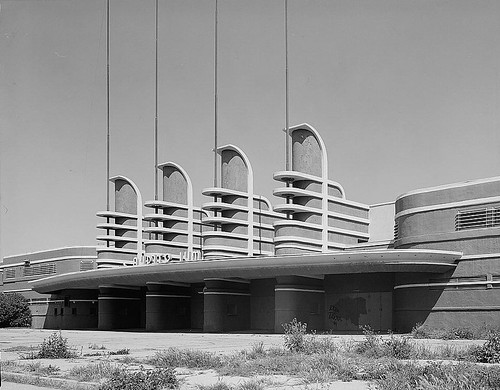
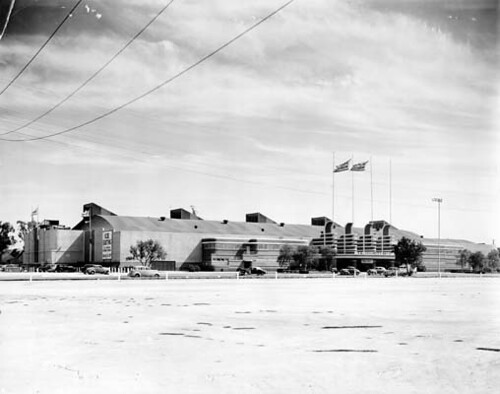
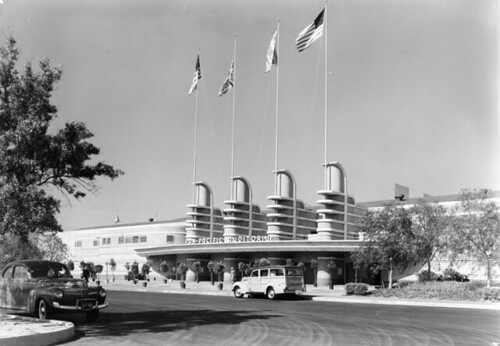
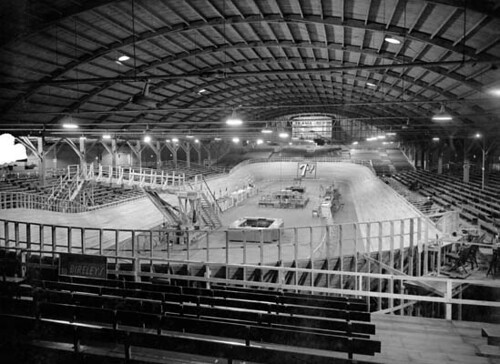
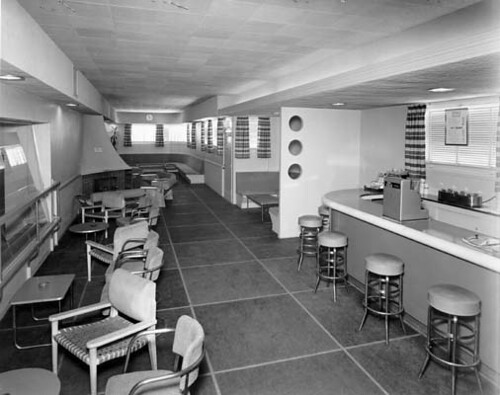
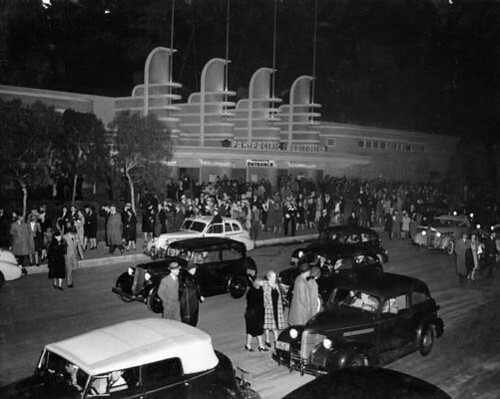
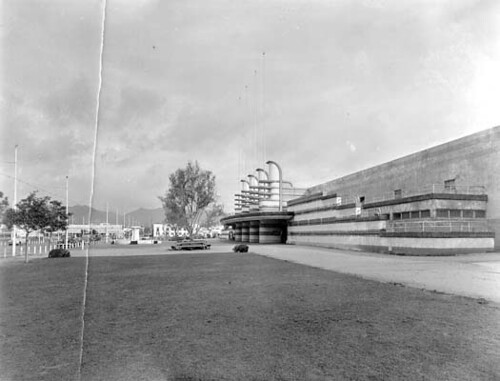
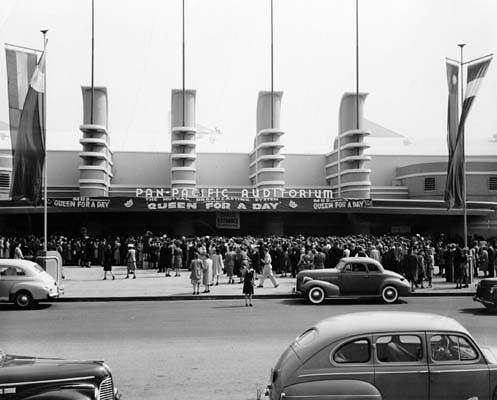
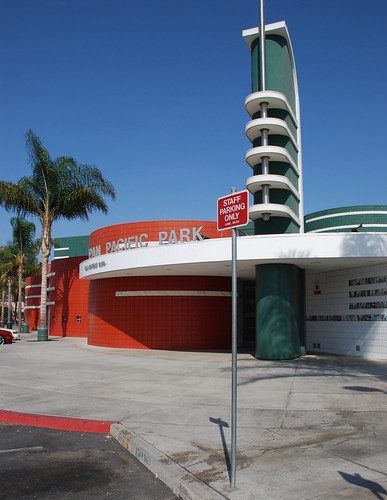
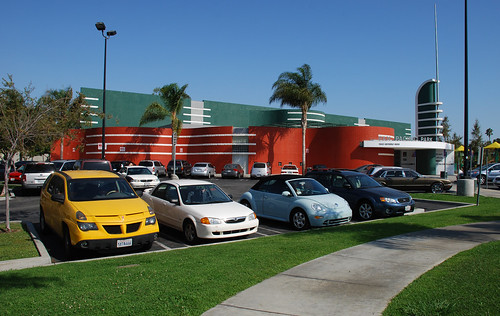
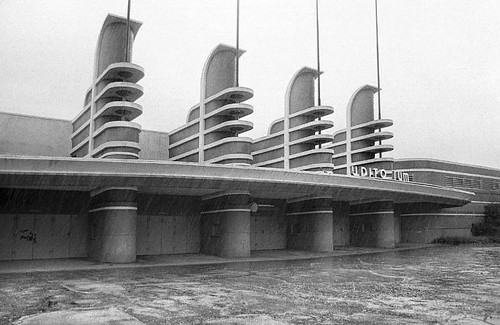
In 1985, the American Cinematheque was negotiating with the city to turn the auditorium into its home. It was just prior to the fire which, of course, scotched that deal.
ReplyDeleteI was working with Gary Essert at that time on his graphics and was asked to do some typesetting (I was the typesetter for Filmex and then American Cinematheque throughout the 1980s) for a poster that David Byrd and Joe Bessera were working on to commemorate the new home of the Cinematheque. David was the brilliant artist who created such iconic posters as Woodstock, Follies, Godspell, and a huge number of others.
The result was the "Temple of Dreams" poster, which you can view at David's web site: http://www.david-edward-byrd.com/more2-03.html.
Thanks, John, for the background and link to David's poster. At least the upside was the Cinematheque did land a pretty nice home.
ReplyDeleteWow, that's a wonderful post. I've done only a little superficial research on this building, in the course of looking for info about another Becket building, and I've never seen the wonderful photos you have posted before. Thank you so much!!
ReplyDeleteI just discovered your blog and i'm exploring it. It's quite wonderful!
Thanks, G. I use about half a dozen online sources for photos. I try always to credit them, but if you email me, I'll be glad to send you links to my favorite go-to sites.
ReplyDeleteI fell in love with this building after seeing the movie, "Xanadu," despite the fact that I probably went to an event there at some point in my childhood. I cannot thank you enough for posting its history and these pictures. I cried when it burnt down.
ReplyDeleteHi, Mare. Thanks for the comment. Unfortunately, the facade's remains were torn away just a few weeks after I arrived in L.A. (no connection, of course). It's probably hard for you to believe it's been nearly twenty years the auditorium's been gone.
ReplyDeleteHello again,
ReplyDeleteIsn't there a building in Pasadena that is very similar to this one?..it's in Old Pas as far as I can remember.
fp
I've always loved this place. The first time I saw it on film was in the movie FUNNY LADY. My wife and I used to live in the neighborhood. (She grew up in the Fairfax.) The late afternoon of the Pan Pacific fire, we walked over and watched the fire and the fire department with several other neighbors. The guy, I forget his name, who runs the ice cream concession at Farmers' Market told me he had film footage of the fire.
ReplyDeleteThis country murders and destroys all that
ReplyDeleteinspires dreams, wonderment, & escapism. My soul crushed & bled in 1989 by the destruction of such beauty. My soul died 20 years later on June 25th 2009. The King to it with him. Now all my dreams are destroyed. There is nothing left. Not even Neverland.
Michelle Basart
Fairview, Oregon
if you loved the pan pacific auditorium
ReplyDeletego here and join
http://ppaplayground.ning.com/
my eyes started to water when i realized this building is no more. ever since i saw Xanadu i have wanted to see it. but never looked into its location. i used to travel all around that area it being so close to the beverly center. i love and collect art deco and although thee are many great examples in los angelse but i always wanted to see this one. by the way many of the other art deco buildings are also being seriously neglected. Michael Romo
ReplyDeleteHas anyone ever noticed in the movie XANADU that in the daytime views of the Pan Pacific Auditorium that the letter "T" is in the word "AUDITORIUM" but in the night-time views of the place the letter "T" is missing? I love the PPA and it's use in XANADU but I did notice that little oddity.
ReplyDeleteThanks Floyd... I am a huge fan of Art Deco... real pity, could not be saved. Certainly that time from from the mid-30s into the 50's was very stylish compared to a majority of modern things. I saw the great Larry Grossman 'Motorama' poster art.
ReplyDeleteSuch a pity when things like PPA are lost. john